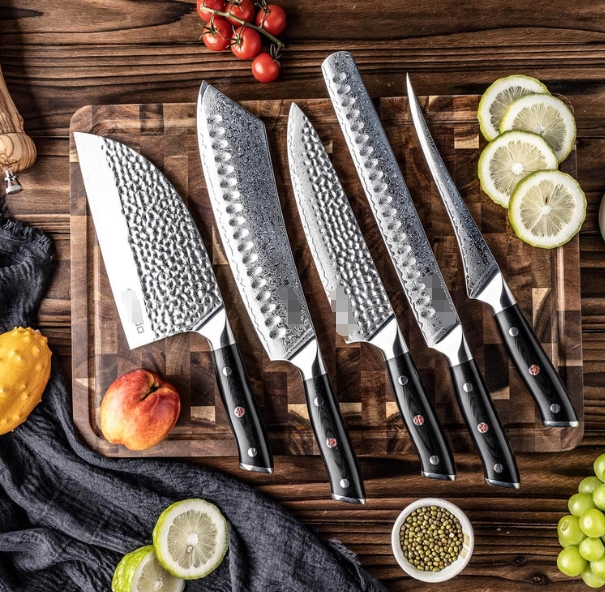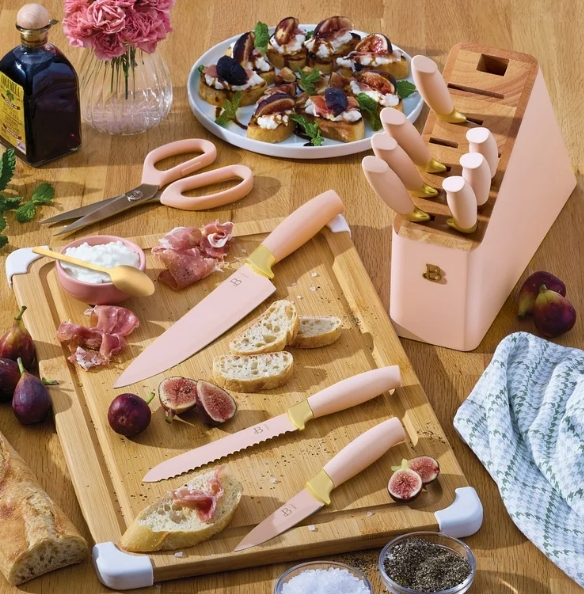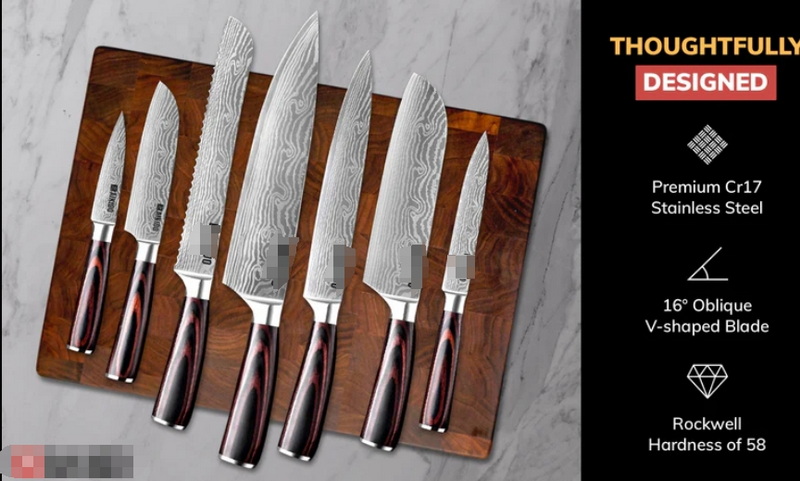

Views: 222 Author: Ella Publish Time: 2025-04-18 Origin: Site








Content Menu
● Chef Knife: The Workhorse of the Kitchen
>> Why the Chef Knife Stands Out
>> When a Chef Knife Isn't Enough
● Knife Sets: Variety and Convenience
>> Scenarios Where Both Make Sense
● How to Choose the Right Knife(s) for You
● FAQ: Top 5 Common Questions Answered
>> 1. Should I buy a knife set or individual knives?
>> 2. What are the three essential knives every kitchen needs?
>> 3. Are expensive knives worth it?
>> 4. How should I store my kitchen knives?
>> 5. How often should I sharpen my knives?
Choosing the right knives is one of the most important decisions for any home cook or aspiring chef. The debate between investing in a comprehensive knife set or relying on a single, high-quality chef knife is ongoing, with passionate advocates on both sides. In this in-depth guide, we'll explore the pros and cons of knife sets versus chef knives, examine what you really need for your kitchen, and help you make the most informed decision. Along the way, you'll find illustrative images and video recommendations to enhance your understanding.

Knives are the backbone of every kitchen. Whether you're dicing onions, slicing bread, or trimming meat, the right blade makes all the difference. But do you really need a full set of knives, or is a single chef knife enough for most tasks? This article will help you answer that question with clarity and confidence.
A chef knife is an all-purpose kitchen tool, usually 8 inches long (though sizes range from 6 to 14 inches), with a broad, slightly curved blade. Its design allows for rocking motions, making it ideal for chopping, mincing, slicing, and dicing a wide variety of foods[5][9][11].
Chef Knife Example:
- Length: 6–14 inches (8 inches is most common)
- Broad, curved blade for rocking motions
- Versatile: suitable for 80% of kitchen tasks[5][15]
- Comfortable grip for extended use
A knife set typically includes several knives designed for specific tasks, such as a chef knife, paring knife, bread knife, utility knife, and sometimes specialty blades like boning or carving knives. Sets often come with a storage block and sometimes include extras like kitchen shears or honing steels[11][12][13].
KeyFeatures:
- Chef knife
- Paring knife
- Bread knife
- Utility knife
- Carving knife
- Storage block or magnetic strip
- Optional: kitchen shears, honing steel
The chef knife is often called the “workhorse” of the kitchen for good reason. It's capable of handling almost every prep task, from chopping vegetables to slicing meat[5][9][15]. Many professional chefs and experienced home cooks rely on a single, high-quality chef knife for the majority of their work.
Advantages:
- Handles most cutting, chopping, and slicing tasks
- Easy to maintain and store
- Encourages skill development and knife mastery
- High-quality chef knives can last a lifetime with proper care[4][8][14]
Despite its versatility, a chef knife isn't perfect for every task. Small, delicate work (like peeling fruit) or slicing bread is better handled by specialized knives[5][11].

Knife sets offer a convenient, all-in-one solution for cooks who want a range of tools at their disposal. For beginners or those who prepare a wide variety of dishes, a set can be appealing[11][12][13].
Advantages:
- Ready access to specialized knives for specific tasks
- Cohesive, matching appearance
- Often includes storage solutions (blocks, magnetic strips)
- Good value if you use most of the included knives
Disadvantages:
- Many sets include “filler” knives you may never use[8][14]
- Quality may be inconsistent across the set
- More expensive upfront than buying one or two knives
- Takes up more counter or drawer space
Chef Knife vs Knife Set: Side-by-Side Comparison
| Feature | Chef Knife Only | Knife Set |
|---|---|---|
| Versatility | Extremely high, covers 80% of tasks | High, covers all tasks with specialized tools |
| Cost | Lower upfront, higher per knife | Higher upfront, lower per knife if all used |
| Learning Curve | Encourages skill with one tool | May overwhelm beginners with options |
| Storage | Compact, easy to store | Bulky (block) or needs more space |
| Quality | Easier to buy top-tier single knife | Varies; some sets have lower quality knives |
| Maintenance | Simple, one blade to care for | Multiple blades, possibly different steels |
| Appearance | Mismatched if buying individually | Cohesive, matching design |
| Customization | High: buy only what you need | Low: fixed selection in set |
While many home cooks can get by with just a chef knife (plus a paring and bread knife), there are situations where a set is justified:
- Frequent entertainers: If you cook large meals or host often, having multiples of each knife can speed up prep and allow helpers to assist[3][13].
- Diverse cooking styles: If you regularly prepare bread, carve roasts, fillet fish, or debone poultry, specialized knives are valuable[5][15].
- Aesthetics and storage: If you value a matching set and a tidy countertop, a knife block set may appeal to you[12][13].
Most experts agree: for the average home cook, three knives are enough—a chef knife, a paring knife, and a bread knife[4][10][14].
- Do you cook daily or occasionally?
- What types of food do you prepare most?
- Do you value aesthetics, or is function your priority?
- Are you comfortable maintaining multiple knives?
- Invest in a high-quality chef knife first; it will handle most tasks[8][14].
- Add a paring knife for delicate work and a bread knife for baked goods as needed[10][13].
- Only expand to a set if you find yourself needing more specialized blades.
- Handle knives in person if possible. The right balance and grip are essential for safety and comfort[8][9].
- Sharpen regularly: A sharp knife is safer and more effective.
- Hand wash only: Avoid dishwashers, which can dull and damage blades.
- Store safely: Use a knife block, magnetic strip, or blade guards to protect edges and fingers[14].
- Dry immediately: Prevent rust and corrosion by drying knives after washing.
Do you really need both a knife set and a chef knife? For most home cooks, a single high-quality chef knife—possibly supplemented by a paring and bread knife—is all that's necessary for daily cooking. Knife sets can be valuable if you routinely use specialized blades, entertain often, or simply prefer the look and convenience of a matching set.
Ultimately, the best approach is to invest in quality over quantity. Start with a chef knife, add essentials as needed, and only consider a full set if your cooking style truly demands it. Remember: a sharp, well-maintained knife—regardless of type—is your most important kitchen ally.

It depends on your needs. Knife sets are convenient and often cost-effective if you use most of the included knives. However, buying individual knives allows you to customize your collection and often results in higher quality per knife[4][7][14].
Most experts recommend a chef knife, a paring knife, and a bread knife. These three can handle almost all kitchen tasks[4][10][13][14].
Yes, high-quality knives are more durable, comfortable, and maintain their edge longer. They can last a lifetime with proper care and are often safer and more enjoyable to use[4][8][12].
Store knives in a block, on a magnetic strip, or with blade guards. Avoid tossing them in a drawer, as this can dull the blades and pose a safety hazard[14].
It depends on usage, but most home cooks should sharpen their knives every few months and hone them regularly to maintain the edge[4][14].
[1] https://www.reddit.com/r/Cooking/comments/kv895k/knife_blocks_or_individual_knives/
[2] https://www.istockphoto.com/photos/chef-knife
[3] https://www.youtube.com/watch?v=8wgc7rv5WJc
[4] https://oishya.com/journal/is-it-better-to-buy-a-kitchen-knife-set-or-individual-knives/
[5] https://madeincookware.com/blogs/types-of-kitchen-knives
[6] https://www.youtube.com/watch?v=QgVyN6Lpiuc
[7] https://elementknife.com/pages/common-questions-about-kitchen-knives
[8] https://www.businessinsider.com/guides/kitchen/should-you-buy-a-knife-set-opinion
[9] https://www.escoffier.edu/blog/culinary-arts/different-knives-and-the-best-uses-for-each/
[10] https://www.youtube.com/watch?v=st6LggwoL_4
[11] https://knife-depot.com/pages/the-complete-guide-to-buying-kitchen-knives
[12] https://www.tasteofhome.com/collection/best-kitchen-knife-sets/
[13] https://www.knivesandtools.com/en/ct/buying-guide-knife-sets.htm
[14] https://www.seriouseats.com/the-best-essential-knives
[15] https://kamikoto.com/blogs/fundamentals/understanding-kitchen-knives-types
[16] https://madeincookware.com/blogs/types-of-kitchen-knives
[17] https://www.youtube.com/watch?v=QgVyN6Lpiuc
[18] https://www.foodandwine.com/lifestyle/kitchen/best-knife-block-set
[19] https://www.seriouseats.com/western-versus-japanese-style-chefs-knives-6751328
[20] https://stock.adobe.com/search?k=chef+knife
[21] https://www.istockphoto.com/photos/kitchen-knife-set
[22] https://www.shutterstock.com/search/chef-knife-set
[23] https://www.youtube.com/watch?v=N46Bany7mus
[24] https://www.youtube.com/watch?v=LO35cdWL1MQ
[25] https://www.youtube.com/watch?v=AcLD4SKY9Js
[26] https://www.reddit.com/r/chefknives/comments/ngdsyy/the_video_that_helped_explain_the_basics_of_chef/
[27] https://www.reddit.com/r/cookingforbeginners/comments/yuqucc/need_help_choosing_between_two_knife_sets_i_know/
[28] https://www.youtube.com/watch?v=7R2jIyPvcx0
[29] https://www.youtube.com/watch?v=GjHaMLsHUUQ
[30] /kitchen-knife-vs-chef-knife-what-s-the-real-difference.html
[31] https://www.reddit.com/r/Cooking/comments/ynuame/amazing_chefs_knife_vs_a_decent_knife_set/
[32] https://www.reddit.com/r/Cooking/comments/kv895k/knife_blocks_or_individual_knives/
[33] https://www.wusthof.com/knives-by-type
[34] https://www.reddit.com/r/cookingforbeginners/comments/1781thp/knife_buying_guide/
What's the Difference Between a Chef Knife and a Kitchen Knife?
What's the Difference Between a Chef Knife and a Gyuto Knife?
What's the Difference Between an 8-Inch and 10-Inch Chef Knife?
What's the Difference Between Carbon Steel and Stainless Steel Chef Knives?
What's the Difference Between Western and Japanese Chef Knives?
Knife Set vs Utility Knife Collection: Which One Is More Practical?